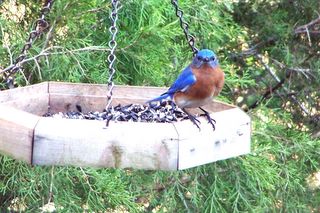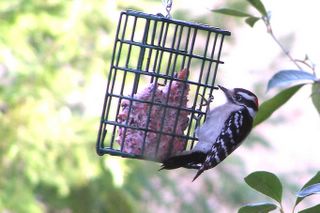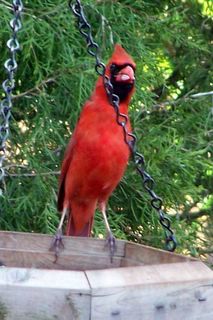God rest the soul of Terri Schiavo.
She will no longer have to be center stage of a media circus. Whether or not Terri would have chosen life support or death is now irrelevant, but I wager she would NEVER have chosen to become such a spectacle in the press.
If any good comes from this sensationalized personal conflict, hopefully it is the awakening of America to the necessity of having a living will. If for no other reason than to force the media to find something else over which to be outraged.
Thursday, March 31, 2005
Tuesday, March 29, 2005
Take responsibility for yourself
Good old Reader's Digest - one of my favorite magazines - has done it again with a "duh" article.
In the April 2005 issue, p. 102, an article titled, "A Dose of Reality" by Irene S. Levine, Ph.D., talks about the risks involved in prescription drugs and how to decide if you ignore them or not. It begins with the removal of Vioxx from the market and the subsequent panic in America.
Significantly, it continues with the quote, "Suddenly, ads for the drug were replaced with ads looking for Vioxx 'victims.'" Here we go again. Law firms jumped at the chance to encourage law suits by those who had taken Vioxx. (which, by the way, was a wonder drug for my arthritis). Merck stock plummeted, and they could be liable for billions of dollars.
Now we're dubious about still more drugs. We accuse the FDA of hiding information; we question the efficacy of clinical trials. Then it raises a very valid question: "Do Americans expect drugs to be risk-free? And, if someone suffers a bad reaction, will lawyers rather than doctors be the first people we call?"
And, I wonder, who is responsible for underwriting (pun intended) this distrust and panic? Answer: the US media. We hear about the bad side effects for a few people and the sensationalized removal of a drug from pharmacy shelves. The news is delivered with accusatory dialogue as though it were a travesty and an outrage. We hear it, and we begin to doubt our physicians and our pharmaceutical companies. As the article points out, out of fear we also decide to eliminate other of our meds: a risky venture in some cases.
When do we begin to take responsibility for ourselves? With all the information available through the internet, through pharmacists and physicians, and through distributed inserts in the prescriptions themselves, when do we begin to inform ourselves about the drugs we take and the side effects?
Prescription drugs have aided in the longer life expectancy that we now enjoy. We beg for drugs to cure terrible diseases like cancer and HIV, yet we're quick to call an attorney if we suffer a side effect from ones already on the shelves. What incentive is this for drug companies to invest in R&D for newer, better drugs?
We need to wake up, arm ourselves with information, make intelligent decisions, and take responsibility for our own welfare. More importantly, we need to remember that no medicine is entirely risk-free because no human being is exactly like the others. And we need to take the media outrage with a grain of salt before overreacting.
And that's how I see it.
In the April 2005 issue, p. 102, an article titled, "A Dose of Reality" by Irene S. Levine, Ph.D., talks about the risks involved in prescription drugs and how to decide if you ignore them or not. It begins with the removal of Vioxx from the market and the subsequent panic in America.
Significantly, it continues with the quote, "Suddenly, ads for the drug were replaced with ads looking for Vioxx 'victims.'" Here we go again. Law firms jumped at the chance to encourage law suits by those who had taken Vioxx. (which, by the way, was a wonder drug for my arthritis). Merck stock plummeted, and they could be liable for billions of dollars.
Now we're dubious about still more drugs. We accuse the FDA of hiding information; we question the efficacy of clinical trials. Then it raises a very valid question: "Do Americans expect drugs to be risk-free? And, if someone suffers a bad reaction, will lawyers rather than doctors be the first people we call?"
And, I wonder, who is responsible for underwriting (pun intended) this distrust and panic? Answer: the US media. We hear about the bad side effects for a few people and the sensationalized removal of a drug from pharmacy shelves. The news is delivered with accusatory dialogue as though it were a travesty and an outrage. We hear it, and we begin to doubt our physicians and our pharmaceutical companies. As the article points out, out of fear we also decide to eliminate other of our meds: a risky venture in some cases.
When do we begin to take responsibility for ourselves? With all the information available through the internet, through pharmacists and physicians, and through distributed inserts in the prescriptions themselves, when do we begin to inform ourselves about the drugs we take and the side effects?
Prescription drugs have aided in the longer life expectancy that we now enjoy. We beg for drugs to cure terrible diseases like cancer and HIV, yet we're quick to call an attorney if we suffer a side effect from ones already on the shelves. What incentive is this for drug companies to invest in R&D for newer, better drugs?
We need to wake up, arm ourselves with information, make intelligent decisions, and take responsibility for our own welfare. More importantly, we need to remember that no medicine is entirely risk-free because no human being is exactly like the others. And we need to take the media outrage with a grain of salt before overreacting.
And that's how I see it.
Thursday, March 24, 2005
Back in the Old Days
When my mother died and my dad moved into Assisted Living, we had to empty the contents of their house before we sold it. We found boxes and boxes of old photographs, diaries, letters, and newspaper clippings. It inspired me to begin researching our ancestry. I learned some very fascinating things about our family.
Our great++ grandfather, Col. William Graham, was preparing to fight in the Battle of King's Mountain during the American Revolution. Just prior to the beginning of the battle against the loyalists, Col. Graham received word that his wife was in labor and was having a rough time. In those days, neither doctors or midwives delivered the babies; it was up to the husbands to assist. Col. Graham had a decision to make: stay and fight or return home just over the hill to assist his wife. He asked for permission to leave. His fellow colonels agreed to allow him to go. He was able to return to the fight near its end. Unfortunately, the colonel appointed to replace Graham at the head of his division was killed during the battle. Thereafter, there were those who labeled Graham a "coward" for deserting his post. He railed over that slur for years afterward.
I discovered a letter from one of my great+ aunts who recalled her daddy describing how his father (Col. Graham) would shake his cane and curse the man who called him a coward. She told of a man named Draper who was writing a history of the area at that time, and she encouraged her cousin, my great+ grandmother, to assist her in "restoring the good name" of their ancestor in their accounts to this Mr. Draper.
Can you imagine living during those difficult times? When the threat of Indians attacking your home was very real? When wars were fought hand-to-hand with swords and horses? When you only bathed maybe twice a year? When it was commonplace for families to have 13 children and babies often died?
I'll include some other stories I uncovered in a future post. Meanwhile check out the following:
My daughter sent me these interesting tidbits:
Our great++ grandfather, Col. William Graham, was preparing to fight in the Battle of King's Mountain during the American Revolution. Just prior to the beginning of the battle against the loyalists, Col. Graham received word that his wife was in labor and was having a rough time. In those days, neither doctors or midwives delivered the babies; it was up to the husbands to assist. Col. Graham had a decision to make: stay and fight or return home just over the hill to assist his wife. He asked for permission to leave. His fellow colonels agreed to allow him to go. He was able to return to the fight near its end. Unfortunately, the colonel appointed to replace Graham at the head of his division was killed during the battle. Thereafter, there were those who labeled Graham a "coward" for deserting his post. He railed over that slur for years afterward.
I discovered a letter from one of my great+ aunts who recalled her daddy describing how his father (Col. Graham) would shake his cane and curse the man who called him a coward. She told of a man named Draper who was writing a history of the area at that time, and she encouraged her cousin, my great+ grandmother, to assist her in "restoring the good name" of their ancestor in their accounts to this Mr. Draper.
Can you imagine living during those difficult times? When the threat of Indians attacking your home was very real? When wars were fought hand-to-hand with swords and horses? When you only bathed maybe twice a year? When it was commonplace for families to have 13 children and babies often died?
I'll include some other stories I uncovered in a future post. Meanwhile check out the following:
My daughter sent me these interesting tidbits:
- George Washington's days, there were no cameras. One's image was either sculpted or painted. Some paintings of George Washington showed him standing behind a desk with one arm behind his back while others showed both legs and both arms. Prices charged by painters were not based on how many people were to be painted, but by how many limbs were to be painted. Arms and legs are "limbs," therefore painting them would cost the buyer more. Hence the expression, "Okay, but it'll cost you an arm and a leg."
- As incredible as it sounds, men and women took baths only twice a year (May and October)! Women kept their hair covered, while men shaved their heads (because of lice and bugs) and wore wigs. Wealthy men could afford good wigs made from wool. They couldn't wash the wigs, so to clean them they would carve out a loaf of bread, put the wig in the shell, and bake it for 30 minutes. The heat would make the wig big and fluffy, hence the term big wig." Today we often use the term "here comes the Big Wig" because someone appears to be or is powerful and wealthy.
- In the late 1700s, many houses consisted of a large room with only one chair. Commonly, a long wide board folded down from the wall, and was used for dining. The "head of the household" always sat in the chair while everyone else ate sitting on the floor. Occasionally a guest, who was usually a man, would be invited to sit in this chair during a meal. To sit in the chair meant you were important and in charge. They called the one sitting in the chair the "chair man." Today in business, we use the expression or title "Chairman" or "Chairman of the Board."
- Personal hygiene left much room for improvement. As a result, many women and men had developed acne scars by adulthood. The women would spread bee's wax over their facial skin to smooth out their complexions. When they were speaking to each other, if a woman began to stare at another woman's face she was told, "mind your own bee's wax." Should the woman smile, the wax would crack, hence the term "crack a smile." In addition, when they sat too close to the fire, the wax would melt . . . therefore, the expression losing face."
- Ladies wore corsets, which would lace up in the front. A proper and dignified woman as in "straight laced". . . wore a tightly tied lace.
- Common entertainment included playing cards. However, there was a tax levied when purchasing playing cards but only applicable to the "Ace of Spades." To avoid paying the tax, people would purchase 51 cards instead. Yet, since most games require 52 cards, these people were thought to be stupid or dumb because they weren't "playing with a full deck."
- Early politicians required feedback from the public to determine what the people considered important. Since there were no telephones, TV's or radios the politicians sent their assistants to local taverns, pubs, and bars. They were told to "go sip some ale" and listen to people's conversations and political concerns. Many assistants were dispatched at different times. You go sip here" and "You go sip there." The two words "go sip" were eventually combined when referring to the local opinion and, thus we have the term "gossip."
- At local taverns, pubs, and bars, people drank from pint and quart-sized containers. A bar maid's job was to keep an eye on the customers and keep the drinks coming. She had to pay close attention and remember who was drinking in "pints" and who was drinking in "quarts," hence the term minding your "P's and Q's."
- One more: bet you didn't know this! In the heyday of sailing ships, all war ships and many freighters carried iron cannons. Those cannons fired round iron cannon balls. It was necessary to keep a good supply near the cannon. However, how to prevent them from rolling about the deck? The best storage method devised was a square-based pyramid with one ball on top, resting on four resting on nine, which rested on sixteen. Thus, a supply of 30 cannon balls could be stacked in a small area right next to the cannon. There was only one problem...how to prevent the bottom layer from sliding or rolling from under the others. The solution was a metal plate called a "Monkey" with 16 round indentations. However, if this plate were made of iron, the iron balls would quickly rust to it. The solution to the rusting problem was to make "Brass Monkeys." Few landlubbers realize that brass contracts much more and much faster than iron when chilled. Consequently, when the temperature dropped too far, the brass indentations would shrink so much that the iron cannonballs would come right off the monkey. Thus, it was quite literally, "Cold enough to freeze the balls off a brass monkey." (All this time, you thought that was an improper expression, didn't you.)
Tuesday, March 22, 2005
Help Me, O Wise Techies
Okay. I need help from one of you all-knowing computer wizards out there. Google AdSense can't seem to solve my problem. Windows Support can't seem to tell me the answer. Blogger doesn't seem to know the answer either.
Here is the dilemma:
My Blog shows up just as I want it to on Mozilla Firefox and Netscape. BUT on AOL, Internet Explorer, and MSN my sidebar items do not appear on my Main Page; however they do appear on individual post pages.
What gives?
I know just enough HTML and computer stuff to be dangerous. I've enabled JavaScript. I've reset my web options. I've enabled passive FTP. I've renamed my HOSTS file. All my browser settings are set alike. This is driving me crazy! Before I renamed my HOSTS file, my Google ads wouldn't appear on any browser except AOL. Now even that has changed.
Ten gold stars to whoever can figure this out.
Here is the dilemma:
My Blog shows up just as I want it to on Mozilla Firefox and Netscape. BUT on AOL, Internet Explorer, and MSN my sidebar items do not appear on my Main Page; however they do appear on individual post pages.
What gives?
I know just enough HTML and computer stuff to be dangerous. I've enabled JavaScript. I've reset my web options. I've enabled passive FTP. I've renamed my HOSTS file. All my browser settings are set alike. This is driving me crazy! Before I renamed my HOSTS file, my Google ads wouldn't appear on any browser except AOL. Now even that has changed.
Ten gold stars to whoever can figure this out.
Saturday, March 19, 2005
Takin' It to the Limit
We went to The Eagles' concert last week, and I gotta tell you, the old guys can still rock.
The arena was packed, mostly with BabyBoomers. After all, the Eagles got together in the early 70's - about the time we could afford to start paying for albums and cassettes. Their songs have spanned our generation. We grew up with "Take It Easy"in 1972 to "Best of My Love" in 1975 to "Heartache Tonight" in 1979 all the way to "Get Over It" in 1994. Not to mention their sabbatical from 1980-1994 during which time they did their own things.
On this tour they had substantial assistance with an outstanding young lead guitarist, an additional percussionist, keyboardist, and brass section that doubled as backup singers and strings players. The first third of the night was dedicated to their more mellow songs, like "Tequila Sunrise," Glenn Frey's "You Belong to the City," and Timothy B. Schmidt's "I Can't Tell You Why." Then they took a break.
I could tell my better half was wondering if we'd spent our money on a mediocre concert; I reminded him that these fellows were older than we are!
The guys changed into more casual attire and began the second two-thirds of the show sitting on bar stools, and furthering our impression that they weren't up to their old rockin' selves. Then they put away the stools, and the real show began.
Glenn Frey introduced Joe Walsh who mumbled into the mike, "So, how's your century going?" The crowd did its usual whistling and cheering, after which he said, "I never thought I'd even be in this century!" (More whistling and cheering). Then he sequed into "Funk 49," and we knew the old guys still had it. The final third spotlighted a lot of Walsh's guitar virtuoso with more of his James Gang repertoire. They don't call him a guitar great for nothing. Schmidt and Frey kept up with him on bass, keyboards, and acoustic guitar. Henley rocked on drums.
They played three encores: The first, of course, was "Hotel California." Second was Don Henley's "All She Wants to Do is Dance," and last was "Desperado." A concert billed as "the Farewell Tour" was well worth the high ticket price. And I got a tee-shirt.
You know things have changed, however, when those in the crowd who don't carry cigarette lighters hold up their cell phones.
The arena was packed, mostly with BabyBoomers. After all, the Eagles got together in the early 70's - about the time we could afford to start paying for albums and cassettes. Their songs have spanned our generation. We grew up with "Take It Easy"in 1972 to "Best of My Love" in 1975 to "Heartache Tonight" in 1979 all the way to "Get Over It" in 1994. Not to mention their sabbatical from 1980-1994 during which time they did their own things.
On this tour they had substantial assistance with an outstanding young lead guitarist, an additional percussionist, keyboardist, and brass section that doubled as backup singers and strings players. The first third of the night was dedicated to their more mellow songs, like "Tequila Sunrise," Glenn Frey's "You Belong to the City," and Timothy B. Schmidt's "I Can't Tell You Why." Then they took a break.
I could tell my better half was wondering if we'd spent our money on a mediocre concert; I reminded him that these fellows were older than we are!
The guys changed into more casual attire and began the second two-thirds of the show sitting on bar stools, and furthering our impression that they weren't up to their old rockin' selves. Then they put away the stools, and the real show began.
Glenn Frey introduced Joe Walsh who mumbled into the mike, "So, how's your century going?" The crowd did its usual whistling and cheering, after which he said, "I never thought I'd even be in this century!" (More whistling and cheering). Then he sequed into "Funk 49," and we knew the old guys still had it. The final third spotlighted a lot of Walsh's guitar virtuoso with more of his James Gang repertoire. They don't call him a guitar great for nothing. Schmidt and Frey kept up with him on bass, keyboards, and acoustic guitar. Henley rocked on drums.
They played three encores: The first, of course, was "Hotel California." Second was Don Henley's "All She Wants to Do is Dance," and last was "Desperado." A concert billed as "the Farewell Tour" was well worth the high ticket price. And I got a tee-shirt.
You know things have changed, however, when those in the crowd who don't carry cigarette lighters hold up their cell phones.
Wednesday, March 16, 2005
An Angel Among Us
Brian Nichols gunned down a judge, a court reporter, and a customs agent. He pistol whipped a reporter. He allegedly tied up and repeatedly raped a former girlfriend. But when a young woman talked to him about God, he listened. Then he waved a white flag and turned himself in.
For this remarkable young woman, Ashley Smith, life had not always been easy, but she was turning things around. Her husband died in her arms after being stabbed by some shady friends a few years ago. She has a 5 year old daughter whom she sees only one day a week. More importantly, she has returned to her Christian upbringing. (See story at this link: Courthouse Shooting Hostage)
What Ashley did was truly heroic and undoubtably guided by God. Her story is chilling. Read the full transcript of the account as she told it to police: Ashley Smith police transcript
Of note:
Whether or not Brian Nichols sustains the message of Ashley Smith's wisdom remains to be seen, but the world has met a true angel and will not forget her courage or her faith.
For this remarkable young woman, Ashley Smith, life had not always been easy, but she was turning things around. Her husband died in her arms after being stabbed by some shady friends a few years ago. She has a 5 year old daughter whom she sees only one day a week. More importantly, she has returned to her Christian upbringing. (See story at this link: Courthouse Shooting Hostage)
What Ashley did was truly heroic and undoubtably guided by God. Her story is chilling. Read the full transcript of the account as she told it to police: Ashley Smith police transcript
Of note:
". . . I asked him if I could read.and:
He said, "What do you want to read?"
"Well, I have a book in my room." So I went and go it. I got my Bible. And I got a book called "The Purpose-Driven Life."
I turned it to the chapter that I was on that day. It was Chapter 33. And I started to read the first paragraph of it. After I read it, he said, "Stop, will you read it again?"
I said, "Yeah. I'll read it again."
So I read it again to him.
It mentioned something about what you thought your purpose in life was. What were you -- what talents were you given? What gifts were you given to use?
And I asked him what he thought. And he said, "I think it was to talk to people and tell them about you.""
"But after we began to talk, he said he thought that I was an angel sent from God. And that I was his sister and he was my brother in Christ. And that he was lost and God led him right to me to tell him that he had hurt a lot of people. And the families --the people-- to let him know how they felt, because I had gone through it myself."and:
"And I just talked with him a little more, just about --about--we pretty much talked about God. . . what his reason was, why he made it out of there.When the time came for Ashley Smith to go visit her daughter, Brian Nichols gave her some money and asked her if there was anything he could do for her while she was away - like hang her curtains or something. But he knew what would happen when she walked out that door. And he was ready. Thanks to Ashley and to God.
I said "Do you believe in miracles? Because if you don't believe in miracles -- you are here for a reason. You're here in my apartment for some reason. You got out of that courthouse with police everywhere, and you don't think that's a miracle? You don't think you're supposed to be sitting here right in front of me listening to me tell you, you know, your reason here?"
I said, "You know, your miracle could be that you need to -- you need to be caught for this. You need to go to prison and you need to share the word of God with them, with all the prisoners there."
Whether or not Brian Nichols sustains the message of Ashley Smith's wisdom remains to be seen, but the world has met a true angel and will not forget her courage or her faith.
Sunday, March 13, 2005
Still More Backyard Birds
I had good response from my previous bird photos. Here are a few more. Enjoy!

Wassup?

This looks like a pretty good B&B. Think I'll stick around.

A Downy Woodpecker enjoys the suet.

A Carolina Wren on the nugget feeder.

A Rufous-sided Towhee with his mouth full.

A White-throated Sparrow checks out the scenery.

The Slate-colored Junco is a ground feeder.

Ms. Cardinal surveys the back yard.

Mr. Cardinal has a sip of water.

Give it back. That one was mine.

Hey Pal! You're sitting in the food!

'Scuse Me? You in there? We're getting low on seed here.

Wassup?


This looks like a pretty good B&B. Think I'll stick around.


A Downy Woodpecker enjoys the suet.


A Carolina Wren on the nugget feeder.


A Rufous-sided Towhee with his mouth full.


A White-throated Sparrow checks out the scenery.


The Slate-colored Junco is a ground feeder.


Ms. Cardinal surveys the back yard.


Mr. Cardinal has a sip of water.


Give it back. That one was mine.


Hey Pal! You're sitting in the food!


'Scuse Me? You in there? We're getting low on seed here.

Friday, March 11, 2005
The Hand of the Master
My friend, Chris, sent this to me. It's about how a little boy and a piano master illustrate how we can create exquisite things if we allow the hand of the master to guide us along.
Wow.
This story hardly needs any follow-up comments.
But -- you know me. I must.
All too often we get frustrated and weary from trying to make things happen. We waste valuable moments of respite worrying about what might take place and how we can intervene to change the possible outcome. Thinking about it is okay. Planning is a great tool. Worrying is a total waste of tme.
After all, we really aren't in control, are we?
Wouldn't it be less stressful if, after we've put our best efforts into thinking and planning, we trust that God will see things through the way He thinks would be best? Why not relax and let His hand guide us?
We're given choices in life, and sometimes we make poor ones. Sometimes we make decisions without consulting God, and sometimes they turn out badly. Sometimes Satan rears his ugly head and intervenes, trying to test our faith and lure us away from it. But I believe if we remain faithful and believe that God will never leave our side, we can weather any storm. We can create masterpieces.
We just have to listen to the voice of the Master.
Wishing to encourage her young son's progress on the piano, a mother took her boy to a Paderewski concert. After they were seated, the mother spotted an old friend in the audience and walked down the aisle to greet her. Seizing the opportunity to explore the wonders of the concert hall, the little boy rose and eventually explored his way through a door marked "NO ADMITTANCE."
When the house lights dimmed and the concert was about to begin, the mother returned to her seat and discovered that the child was missing. Suddenly the curtains parted, and spotlights focused on the impressive Steinway on stage. In horror, the mother saw her little boy sitting at the keyboard, innocently picking out "Twinkle,Twinkle Little Star."
At that moment, the great piano master made his entrance, quickly moved to the piano, and whispered in the boy's ear, "Don't quit. Keep playing." Then, leaning over, Paderewski reached down with his left hand and began filling in a bass part. Soon his right arm reached around to the other side of the child, and he added a running obligato. Together, the old master and the young novice transformed what could have been a frightening situation into a wonderfully creative experience.
The audience was so mesmerized that they couldn't recall what else the great master played. Only the classic "Twinkle, Twinkle Little Star."
Perhaps that's the way it is with God.
What we can accomplish on our own is hardly noteworthy. We try our best, but the results aren't always graceful flowing music. However, with the hand of the Master, our life's work can truly be beautiful.
The next time you set out to accomplish great feats, listen carefully. You may hear the voice of the Master whispering in your ear, "Don't quit. Keep playing."
May you feel His arms around you and know that His hands are there, helping you turn your feeble attempts into true masterpieces.
Wow.
This story hardly needs any follow-up comments.
But -- you know me. I must.
All too often we get frustrated and weary from trying to make things happen. We waste valuable moments of respite worrying about what might take place and how we can intervene to change the possible outcome. Thinking about it is okay. Planning is a great tool. Worrying is a total waste of tme.
After all, we really aren't in control, are we?
Wouldn't it be less stressful if, after we've put our best efforts into thinking and planning, we trust that God will see things through the way He thinks would be best? Why not relax and let His hand guide us?
We're given choices in life, and sometimes we make poor ones. Sometimes we make decisions without consulting God, and sometimes they turn out badly. Sometimes Satan rears his ugly head and intervenes, trying to test our faith and lure us away from it. But I believe if we remain faithful and believe that God will never leave our side, we can weather any storm. We can create masterpieces.
We just have to listen to the voice of the Master.
Tuesday, March 08, 2005
And the Envelope, Please . . .
Announcing the winners of the ROYAL BONEHEADED EEJITS AWARD:
The nincompoops who drive in the left lane of the freeway at the same speed as those driving in the middle or the right lanes of the freeway.
I write my blogs in my head while I drive, and this one has been screaming to be published for awhile now. At least once a week I travel 45 miles to see my dad, and 80% of it is on the highway. There are some real problem drivers out there, and these are some of the worst!
Any DOT driving handbook clearly states that the far left lane of the highway is specifically designated as the PASSING lane. This means it is to be used for going around another vehicle. It is not intended for casual cruising just because it has the fewest number of cars in it. It is not intended to be used when your cruise control is set to one mph faster than that of the guy in the middle. It is for people who are going faster than the other vehicles and who need to get around them! For cruise controllers, this may mean accelerating around the guy at the 65 mph speed and slowing back down to your 66 mph when you return to the middle lane! Is this a particularly difficult concept to understand?
Or are these nimrods just selfish? There are those who claim that they are doing other drivers a favor by keeping them from getting a ticket for going over the speed limt. To these butterbrains, I say, "Stop playing my mama, and just get outta the way!"
In reality these dimwits are highway hazards. Because they insist on plugging up the passing lane, faster drivers are forced to play the "lane change" game, sometimes having to travel all the way to the far right lane to get ahead. Then they have to navigate back again. Weaving in and out of traffic is not safe under any circumstances. This is why the highway engineers designed PASSING LANES! The road signs say "Slower traffic stay to the right." Can these people not read?
I'd like to see tickets given to people who do this. We've been on trips before and become stuck in traffic moving at a snail's pace. We naturally assumed there was an accident up ahead that had a lane or lanes blocked. Come to find out, after inching along for mile after mile, that it was nothing more than a looneytoon who was driving in the far left lane at the same speed as everyone else, and no one could get around him! Don't they realize that traffic backs up way behind them when they do this?
I don't care what the speed limit signs say. More often than not, the flow of traffic on any given three-lane or larger highway in the United States is traveling at 75 mph. At least. That is until they reach the bozo who brings it all to a halt because he plugs up the left lane. An interesting survey would contain the following questions: How fast do you actually drive on a highway? How fast would you like to drive? I daresay 75% of the answers would NOT be 60 mph! Give the pluggers a ticket and leave the people driving 85, but who are keeping very safe distances away from anyone else, alone. People who are not comfortable driving over 60 can stay in the right lane or the middle lane. Those needing to pass can do so and return to the middle lane until the next time they need to pass. This will work because no one will be driving 65 in the left lane!
I'd like someone to invent flip-up signs that read backwards on the front of the car and forwards on the rear of the car. We could flip up a sign on the front that says, "To the right, please" when we come up behind one of these dumbkopfs. Then we could flip up one on the back that says, "Get off of my bumper, please" when another kind of eejit tailgates. Tailgaters might do well to look beyond the car ahead and see if some air-for-brain is slowing everybody down. Then we could have a third sign for general purposes that says, "Have you lost your mind?"
And that's how I see it.
Oh. The prize for the ROYAL BONEHEADED EEJITS AWARD? This time it's the opportunity to drive a brand new 2005 Ferrari for 500 miles, up a steep grade, while sandwiched in the far right lane between two big rigs that are each heavily laden with concrete and steel, and with a myopic octogenerian in a 1955 Ford Fairlane on the left in the middle lane. An added bonus is getting to watch the rest of the traffic cruising on by, free and clear, in the far left (passing) lane.
The nincompoops who drive in the left lane of the freeway at the same speed as those driving in the middle or the right lanes of the freeway.
I write my blogs in my head while I drive, and this one has been screaming to be published for awhile now. At least once a week I travel 45 miles to see my dad, and 80% of it is on the highway. There are some real problem drivers out there, and these are some of the worst!
Any DOT driving handbook clearly states that the far left lane of the highway is specifically designated as the PASSING lane. This means it is to be used for going around another vehicle. It is not intended for casual cruising just because it has the fewest number of cars in it. It is not intended to be used when your cruise control is set to one mph faster than that of the guy in the middle. It is for people who are going faster than the other vehicles and who need to get around them! For cruise controllers, this may mean accelerating around the guy at the 65 mph speed and slowing back down to your 66 mph when you return to the middle lane! Is this a particularly difficult concept to understand?
Or are these nimrods just selfish? There are those who claim that they are doing other drivers a favor by keeping them from getting a ticket for going over the speed limt. To these butterbrains, I say, "Stop playing my mama, and just get outta the way!"
In reality these dimwits are highway hazards. Because they insist on plugging up the passing lane, faster drivers are forced to play the "lane change" game, sometimes having to travel all the way to the far right lane to get ahead. Then they have to navigate back again. Weaving in and out of traffic is not safe under any circumstances. This is why the highway engineers designed PASSING LANES! The road signs say "Slower traffic stay to the right." Can these people not read?
I'd like to see tickets given to people who do this. We've been on trips before and become stuck in traffic moving at a snail's pace. We naturally assumed there was an accident up ahead that had a lane or lanes blocked. Come to find out, after inching along for mile after mile, that it was nothing more than a looneytoon who was driving in the far left lane at the same speed as everyone else, and no one could get around him! Don't they realize that traffic backs up way behind them when they do this?
I don't care what the speed limit signs say. More often than not, the flow of traffic on any given three-lane or larger highway in the United States is traveling at 75 mph. At least. That is until they reach the bozo who brings it all to a halt because he plugs up the left lane. An interesting survey would contain the following questions: How fast do you actually drive on a highway? How fast would you like to drive? I daresay 75% of the answers would NOT be 60 mph! Give the pluggers a ticket and leave the people driving 85, but who are keeping very safe distances away from anyone else, alone. People who are not comfortable driving over 60 can stay in the right lane or the middle lane. Those needing to pass can do so and return to the middle lane until the next time they need to pass. This will work because no one will be driving 65 in the left lane!
I'd like someone to invent flip-up signs that read backwards on the front of the car and forwards on the rear of the car. We could flip up a sign on the front that says, "To the right, please" when we come up behind one of these dumbkopfs. Then we could flip up one on the back that says, "Get off of my bumper, please" when another kind of eejit tailgates. Tailgaters might do well to look beyond the car ahead and see if some air-for-brain is slowing everybody down. Then we could have a third sign for general purposes that says, "Have you lost your mind?"
And that's how I see it.
Oh. The prize for the ROYAL BONEHEADED EEJITS AWARD? This time it's the opportunity to drive a brand new 2005 Ferrari for 500 miles, up a steep grade, while sandwiched in the far right lane between two big rigs that are each heavily laden with concrete and steel, and with a myopic octogenerian in a 1955 Ford Fairlane on the left in the middle lane. An added bonus is getting to watch the rest of the traffic cruising on by, free and clear, in the far left (passing) lane.
Friday, March 04, 2005
the Singapore Sling
Before I go any further, let me say that I'm usually the designated driver because my drink of choice is water.
BUT. . .
I've learned how to make a mean Singapore Sling.
When I was a teenager, my first drink was Peach Fuzz. Our beach trip chaperone moms mixed up a (very weak) batch and let us have a cup. We thought it was sinfully delicious, even though we were probably dividing one jigger of alcohol between 8 hormonal girls. Recently I phoned my friend to see if she could retrieve the recipe for Peach Fuzz from her mom. After much debate, they came up with what they thought they remembered. I tried it. Either my tastebuds have changed, or I was once so giddy with the idea of having a drink that anything would've tasted good, but this recipe was far too tart for me. After some tweaking, however, I did create a slushy Peach Fuzz drink that was pretty good. (One uses a whole fresh peach- peel and all- hence the name).
As the years progressed, my friends drank beer; I drank screwdrivers. Try though I would, I could never develop a taste for beer. In college, this sometimes presented a problem. At fraternity parties or beer softball games there was obviously no open bar. Times like these, I'd have to bring my own bottle of something like Brass Monkey or Boone's Farm Wild Mountain Grape. (I never lowered myself to the likes of Mad Dog 20/20, however.)
You see, when we were in college, there were no such things as wine coolers or flavored alcohol or Bacardi Ice drinks like there are now. We never heard of ice shooters or funneling or flavored martinis. It was beer, mixed drinks, or a few bottled drinks like the two mentioned above. BUT when we went to someplace like Underground Atlanta or Bourbon Street, we could get some dee-li-cious mixed drinks - like Singapore Slings. Now that was a grand beverage! We could also get a Pina Colada, a Daiquiri, a Bloody Mary, a Margarita, or a Hurricane (at Pat O'Brien's), but the choices were definitely limited.
One weekend my friend, Nancy, and I decided to learn to drink Scotch. It was our turn to decorate the entry-way for the sorority. While we worked, we tried the Scotch in various ways: with soda, with water, probably even with Coke. If my memory serves me correctly, Nancy succeeded in acquiring a taste for the nasty stuff. I thought I would gag. Back to screwdrivers and Brass Monkey for me.
After college graduation and before I became responsible, I even tried the salt, lime, and tequila shots. Once. Only once, and we'll never speak of this again.
The best thing that ever happened to my social drinking was the invention of wine coolers. (Plain wine gives me a headache.) Coolers are fizzy, don't contain too much alcohol, taste good, and come in a totable bottle. No more Brass Monkey. Time went on, and I almost forgot about Singapore Slings.
Rocking on the back porch of a beach house at dusk as one watches the crashing waves and the pelicans riding the air currents is synonomous with slushy drinks. When we planned a family reunion at the beach last year, I embarked on a quest to learn to mix superior pina coladas and daiquiries. (This actually began as trying to learn to make Peach Fuzz, as described above). My friend, Susan, and her husband served as guinea pigs on many a late afternoon when I appeared in their back yard with a pitcher of my latest attempt. It was a tough job, but they were able volunteers. By mid-summer, I had the recipes perfected. (Susan reminds me that I need to keep practicing so as not to lose my skill - and they'll be happy to help out however they can.) Needless to say, I had two blenders whirring many an evening during that week at the beach. No, NOT all for me - we had 16 people!
Recently, for a reason I can't determine, it came to me that I hadn't had a Singapore Sling in years! It is never offered on the backs of menus or beverage lists. It became a challenge. I searched the internet for recipes. I found what purports to be the original recipe created by a Raffles Hotel bartender at the turn-of-the century. (http://www.webtender.com/) Between it and other variations, I was ready to mix. Mine didn't turn out so well. I prefer fruitier, sweeter drinks. This recipe was not to my liking, so I tweaked it. Thought you might like to try it for yourself:
My Version of the Singapore Sling
1 oz. Gin
1/2 oz. Cherry Heering brandy or liqueur
4 oz. pineapple juice
1/2 oz. Rose's sweetened lime juice
1/2 oz. Cointreau
1/8 oz. Benedictine
1/2 oz. Grenadine
Combine all ingredients in a shaker. Add ice, and shake until very cold. Strain into a glass, add the ice from the shaker, and garnish with an umbrella or a pineapple slice and a cherry, or nothing. I like to use a straw.
M-m-m-m good.
Enjoy - in the comfort of your own home - do not drink and drive!
BUT. . .
I've learned how to make a mean Singapore Sling.
When I was a teenager, my first drink was Peach Fuzz. Our beach trip chaperone moms mixed up a (very weak) batch and let us have a cup. We thought it was sinfully delicious, even though we were probably dividing one jigger of alcohol between 8 hormonal girls. Recently I phoned my friend to see if she could retrieve the recipe for Peach Fuzz from her mom. After much debate, they came up with what they thought they remembered. I tried it. Either my tastebuds have changed, or I was once so giddy with the idea of having a drink that anything would've tasted good, but this recipe was far too tart for me. After some tweaking, however, I did create a slushy Peach Fuzz drink that was pretty good. (One uses a whole fresh peach- peel and all- hence the name).
As the years progressed, my friends drank beer; I drank screwdrivers. Try though I would, I could never develop a taste for beer. In college, this sometimes presented a problem. At fraternity parties or beer softball games there was obviously no open bar. Times like these, I'd have to bring my own bottle of something like Brass Monkey or Boone's Farm Wild Mountain Grape. (I never lowered myself to the likes of Mad Dog 20/20, however.)
You see, when we were in college, there were no such things as wine coolers or flavored alcohol or Bacardi Ice drinks like there are now. We never heard of ice shooters or funneling or flavored martinis. It was beer, mixed drinks, or a few bottled drinks like the two mentioned above. BUT when we went to someplace like Underground Atlanta or Bourbon Street, we could get some dee-li-cious mixed drinks - like Singapore Slings. Now that was a grand beverage! We could also get a Pina Colada, a Daiquiri, a Bloody Mary, a Margarita, or a Hurricane (at Pat O'Brien's), but the choices were definitely limited.
One weekend my friend, Nancy, and I decided to learn to drink Scotch. It was our turn to decorate the entry-way for the sorority. While we worked, we tried the Scotch in various ways: with soda, with water, probably even with Coke. If my memory serves me correctly, Nancy succeeded in acquiring a taste for the nasty stuff. I thought I would gag. Back to screwdrivers and Brass Monkey for me.
After college graduation and before I became responsible, I even tried the salt, lime, and tequila shots. Once. Only once, and we'll never speak of this again.
The best thing that ever happened to my social drinking was the invention of wine coolers. (Plain wine gives me a headache.) Coolers are fizzy, don't contain too much alcohol, taste good, and come in a totable bottle. No more Brass Monkey. Time went on, and I almost forgot about Singapore Slings.
Rocking on the back porch of a beach house at dusk as one watches the crashing waves and the pelicans riding the air currents is synonomous with slushy drinks. When we planned a family reunion at the beach last year, I embarked on a quest to learn to mix superior pina coladas and daiquiries. (This actually began as trying to learn to make Peach Fuzz, as described above). My friend, Susan, and her husband served as guinea pigs on many a late afternoon when I appeared in their back yard with a pitcher of my latest attempt. It was a tough job, but they were able volunteers. By mid-summer, I had the recipes perfected. (Susan reminds me that I need to keep practicing so as not to lose my skill - and they'll be happy to help out however they can.) Needless to say, I had two blenders whirring many an evening during that week at the beach. No, NOT all for me - we had 16 people!
Recently, for a reason I can't determine, it came to me that I hadn't had a Singapore Sling in years! It is never offered on the backs of menus or beverage lists. It became a challenge. I searched the internet for recipes. I found what purports to be the original recipe created by a Raffles Hotel bartender at the turn-of-the century. (http://www.webtender.com/) Between it and other variations, I was ready to mix. Mine didn't turn out so well. I prefer fruitier, sweeter drinks. This recipe was not to my liking, so I tweaked it. Thought you might like to try it for yourself:
My Version of the Singapore Sling
1 oz. Gin
1/2 oz. Cherry Heering brandy or liqueur
4 oz. pineapple juice
1/2 oz. Rose's sweetened lime juice
1/2 oz. Cointreau
1/8 oz. Benedictine
1/2 oz. Grenadine
Combine all ingredients in a shaker. Add ice, and shake until very cold. Strain into a glass, add the ice from the shaker, and garnish with an umbrella or a pineapple slice and a cherry, or nothing. I like to use a straw.
M-m-m-m good.
Enjoy - in the comfort of your own home - do not drink and drive!
Subscribe to:
Posts (Atom)
